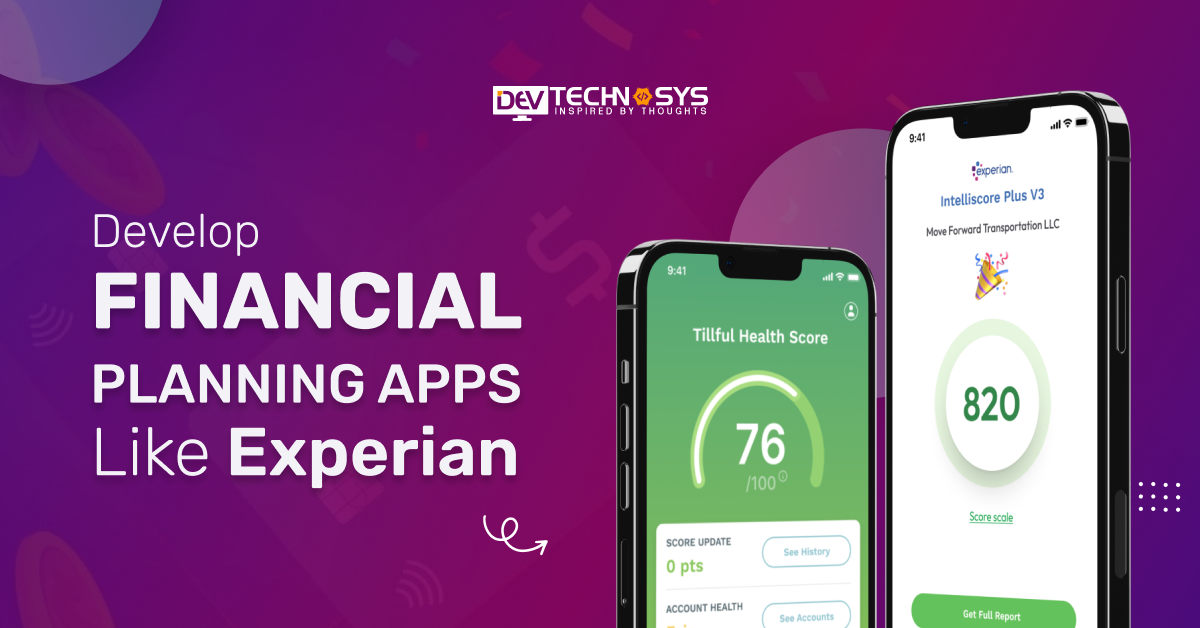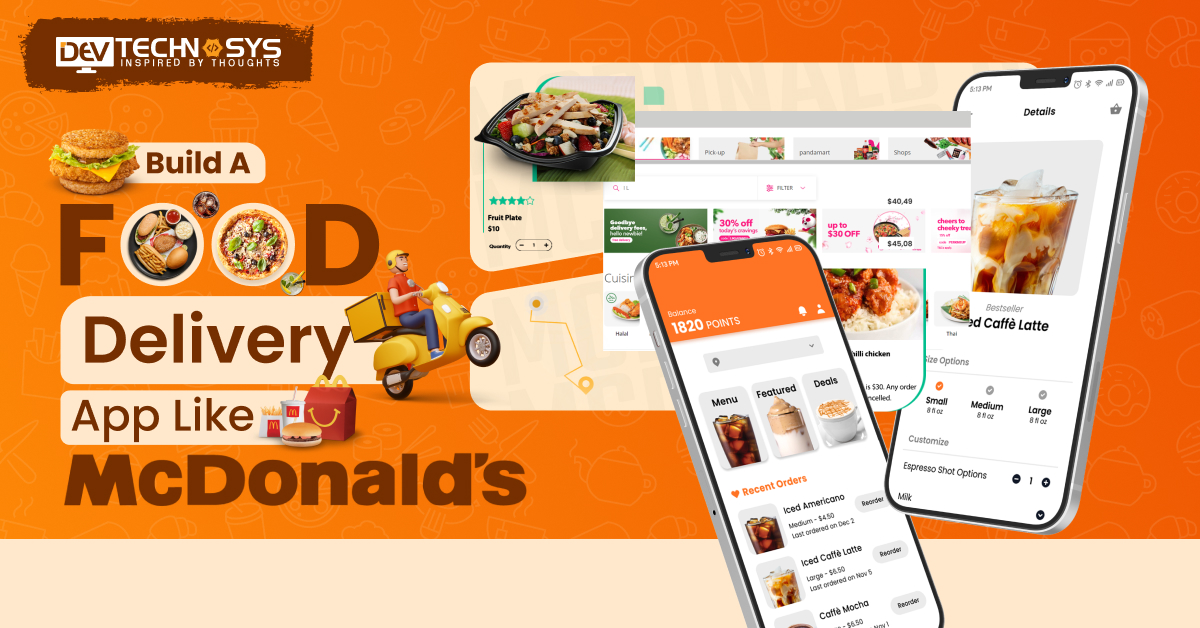In the 21st century, financial management is an essential part of everyday life. From small transactions to bigger amount transactions, it is very complex to manage the financial record. To manage or plan financial records, welcome to an app like Experian. It provides credit scores based on users’ ongoing loans, credit cards, and mortgages, and it can also monitor credit activity to protect from thefts.
As per a recent survey, the financial advisory apps market is valued at around $1.43 billion in 2023. It is expected to reach around $2.80 billion by the end of 2030.
The above data depicts that building financial planning applications like Experian is a lucrative opportunity for entrepreneurs to take their businesses to the next level.
Let’s explore how to develop financial planning apps like Experian, how it can provide higher revenue generation opportunities, and more.
Let’s start!
What is Experian?
The Experian app is a smartphone app that lets users check their credit score, view credit reports, and get instant notifications when their credit file changes. To assist consumers in keeping track of their financial well-being, it provides tools for fraud detection, credit monitoring, and identity theft prevention.
For further security, the app also offers features like tailored suggestions, credit score tracking, and the option to lock or unlock credit reports.
- Credit Score Monitoring
- Credit Report Access
- Personalized Recommendations
- Identity Theft Protection
Market Analysis of Financial Planning Applications
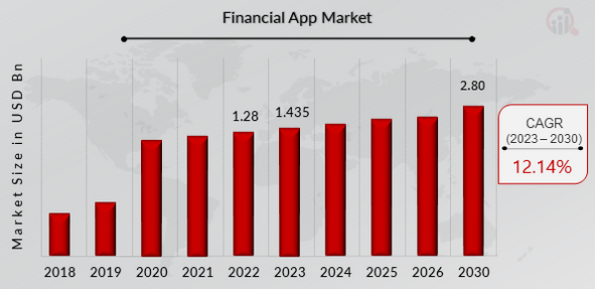
- In 2023, the market for financial portfolio apps is expected to be worth approximately $1.43 By the end of 2030, it is anticipated to have reached approximately $2.80 billion.
- According to a global study, money management apps are projected to grow with a compound annual growth rate of 14% from 2025 to 2030.
- In deep research, the average income per download is now estimated to be US$0.53.
- As per the recent survey, paid app revenue in the Finance sector is expected to reach US$51.67 million by 2024.
- The number of downloads in the finance market is expected to reach 66 billion in 2025.
10 Trending Financial Planning Apps Like Experian
Here’s a table of 10 trending budgeting apps similar to Experian, including download information, ratings, launch year, and platform availability:
Applications |
Download Users |
Stores Ratings |
Apps Launched On |
Platform Accessibility |
| Mint | 50M+ | 4.8 | 2006 | Android, iOS, Web |
| YNAB | 1M+ | 4.6 | 2004 | Android, iOS, Web |
| GoodBudget | 5M+ | 4.6 | 2009 | Android/iOS |
| Clarity Money  | 1M+ | 4.7 | 2016 | Android/iOS |
| Wally | 1M+ | 4.5 | 2012 | Android/iOS |
| Spendee  | 10M+ | 4.7 | 2013 | Android/iOS |
| Acorns | 10M+ | 4.7 | 2014 | Android/iOS |
| Personal Capital | 1M+ | 4.5 | 2009 | Android/iOS |
| PocketGuard | 10M+ | 4.5 | 2014 | Android/iOS |
| Fudget | 500K+ | 4.6 | 2013 | Android/iOS |
Why Most Entrepreneurs Want to Invest in Financial Planning App Development?
Entrepreneurs are investing in wealth management apps because they address a growing consumer need, offer recurring revenue, provide data-driven insights, empower users, and help businesses stay competitive. Entrepreneurs are increasingly investing in fintech application development for several reasons. Here are five key motivations:
- Rising Demand
- Recurring Revenue Potential
- Data-Driven Insights
- Increased Financial Literacy
- Competitive Advantage
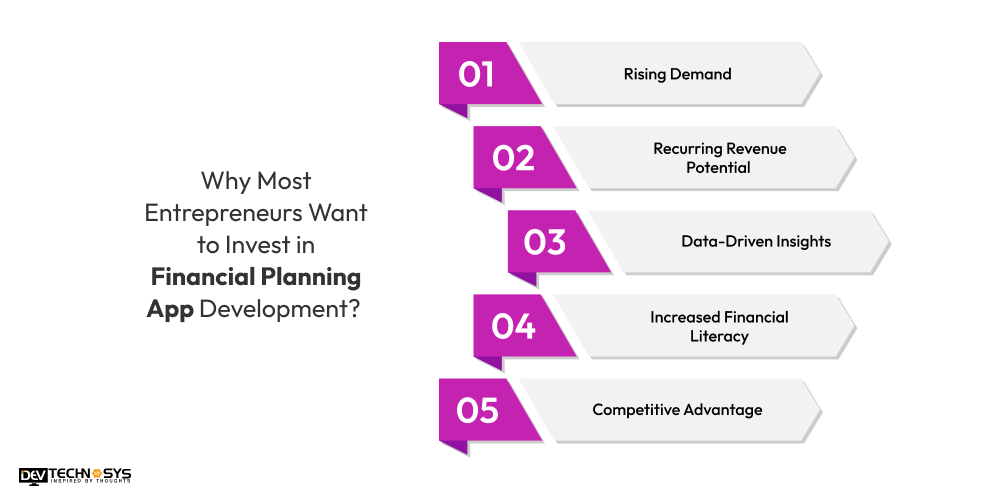
1. Rising Demand
As more people become financially conscious, the demand for digital tools to manage funds has increased dramatically. Consumers want simple tools for tracking their spending, budgeting, saving, and investing. According to the Experian app development company, entrepreneurs can capitalize on this increasing market by developing a financial planning app that is accessible and mobile-friendly.
2. Recurring Revenue Potential
Financial planning applications often use subscription models or in-app sales to provide consistent, recurring revenue streams. This business strategy appeals to entrepreneurs because, unlike traditional one-time sales, it generates regular income over time.
Many apps also provide tiered pricing to accommodate to diverse client needs (e.g., basic users versus premium users), which increases profitability.
3. Data-Driven Insights
Financial apps can collect useful information about users’ spending patterns, financial habits, and ambitions. Entrepreneurs can use this data to deliver individualized recommendations, more targeted marketing, and advanced services such as financial advice or tax optimization.
This personalized experience not only boosts user engagement but it also allows businesses to fine-tune their app’s offers for greater customer satisfaction.
4. Increased Financial Literacy
As more people experience financial insecurity, financial literacy becomes more important. Entrepreneurs recognize that creating apps for financial planning may provide users with knowledge and control over their finances.
As we discussed earlier with an Artificial intelligence development company, entrepreneurs contribute to financial wellness by giving customers tools for making smart budgeting, saving, and investing decisions.
5. Competitive Advantage
In today’s competitive world, entrepreneurs seek to diversify their portfolios. Entering the personal financial market gives companies an advantage, particularly as the fintech business expands.
By creating financial planning software, entrepreneurs position themselves as pioneers in a quickly growing industry, giving them a competitive advantage in a crowded digital market.
7 Easy Steps to Develop Financial Planning Applications Like Experian
There are various steps to develop Experian clone apps with specific functionalities that can easily meet business requirements. You need to observe these steps carefully to build a successful Experian budget app. Let’s start the banking app development process:
- Identify Requirements and Goals
- Identify the Features
- Select Tech Stacks
- Design UI/UX
- App Development
- Testing and QA
- Publishing and Maintenance
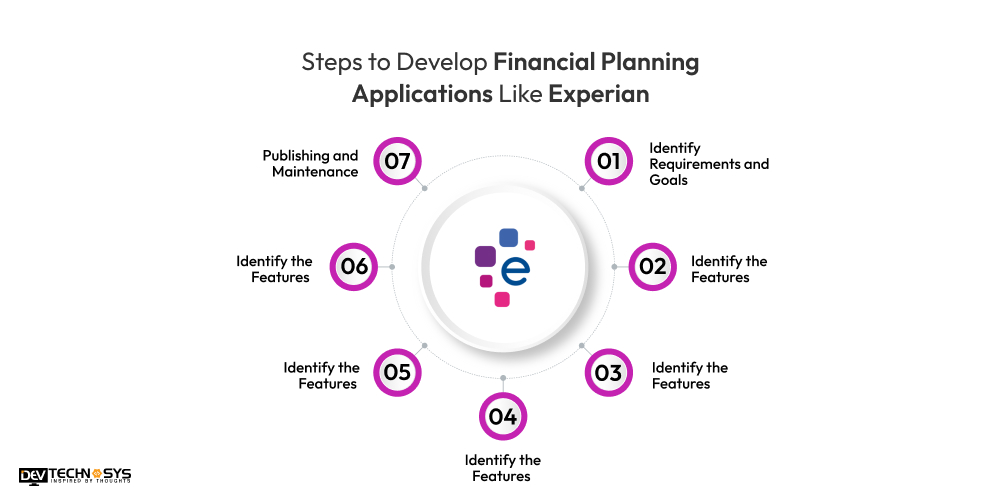
1. Identify Requirements and Goals
Start by understanding the target audience’s needs. Research their financial challenges, preferences, and goals. Create a detailed list of functional and non-functional requirements. This includes defining the core features like budgeting, credit score tracking, and data security to ensure the app serves its intended purpose effectively.
2. Identify the Features
In the second stage of development, hire dedicated developers to identify essential and advanced features such as real-time data syncing, AI-based advice, and financial goal tracking. Prioritize features based on user needs and market trends.
Focus on building a strong foundation with core functionalities, while considering premium features that can be introduced in future updates to drive engagement.
3. Select Tech Stacks
Choose appropriate technologies to build the app’s frontend and backend. Consider languages like Swift or Kotlin for mobile development and frameworks like React or Angular for web apps. Select secure, scalable cloud platforms (AWS, Google Cloud) and APIs for third-party integrations, ensuring smooth functionality and data handling.
4. Design UI/UX
Create an intuitive, visually appealing interface that prioritizes ease of use. The design should be user-friendly, with simple navigation and accessibility in mind.
Hire mobile app developers to deliver a seamless user experience that makes financial tracking and planning effortless. Ensure users can interact with the app effortlessly, even with minimal technical knowledge.
5. App Development
Begin coding the app, implementing both the front-end (user interface) and back-end (data storage, security, APIs). This phase also includes integrating third-party services like credit score providers or financial institutions. Developers should follow agile practices, releasing incremental updates to ensure quality and adaptability as the app evolves.
6. Testing and QA
Thoroughly test the app for functionality, usability, and security. Run multiple tests, including unit testing, integration testing, and stress testing.
Hire a payment app development company to ensure the app works across different devices and platforms and check for bugs, data leaks, or performance issues. Quality assurance guarantees the app meets high standards before release.
7. Publishing and Maintenance
Once the app passes testing, release it to app stores with a strong marketing plan. After launch, monitor user feedback and address any issues promptly. Regularly update the app with bug fixes, new features, and performance enhancements. Ongoing maintenance ensures the app remains functional and competitive in the market.
10 Advanced Features of Financial Planning Apps Like Experian
These advanced features make personal finance apps powerful tools for managing both everyday finances and long-term financial goals.
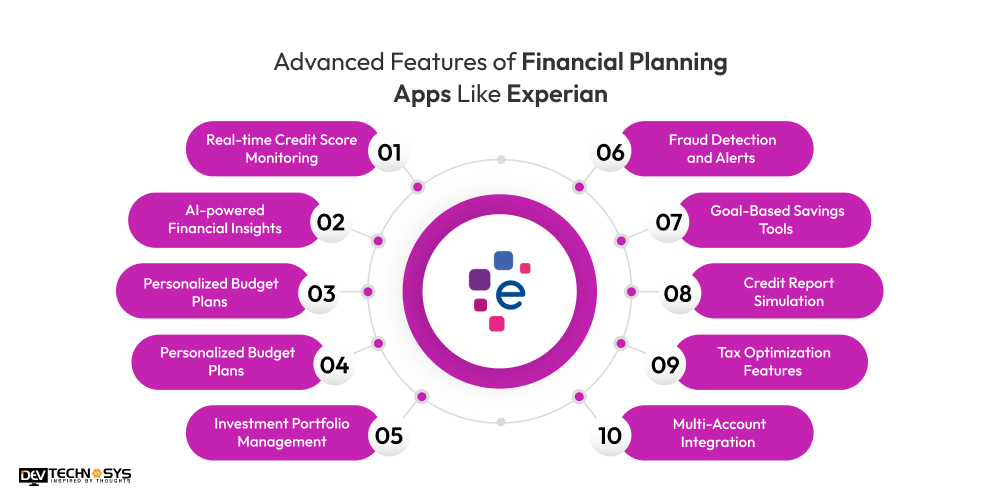
1. Real-time Credit Score Monitoring
Continuously monitor your credit scores from all three main credit agencies, receiving quick updates when your score changes due to activity such as new credit inquiries or account updates.
2. AI-powered Financial Insights
Experian alternatives use artificial intelligence and natural language processing to analyze spending habits and improve credit ratings, control debt, and increase savings.
3. Personalized Budget Plans
The apps like Experian boost create dynamic and personalized budgets that update automatically based on income variations, spending patterns, and financial goals.
4. Automated Expense Tracking
Automatically categorize and track daily costs using linked bank accounts, credit cards, and payment applications to provide a comprehensive financial picture.
5. Investment Portfolio Management
Track and manage your investments, including stocks, bonds, and mutual funds, with real-time performance updates. To integrate this feature into your app, connect with a mobile app development company.
6. Fraud Detection and Alerts
Experian clone apps monitor accounts for unusual activity, such as big or unfamiliar transactions, and give immediate alerts to prevent identity theft or illegal access.
7. Goal-Based Savings Tools
Apps like Geforce Experience offer manage savings goals, such as an emergency fund, vacation, or retirement, using progress tracking and automatic transfers to specified savings accounts.
8. Credit Report Simulation
Experian similar apps simulate changes to credit reports and scores resulting from hypothetical acts, such as debt repayment, to determine how they affect the financial position.
9. Tax Optimization Features
Experian Android app provides tax advice and recommends measures to lower taxable income, such as increasing retirement contributions, to assist users in optimizing their financial condition.
10. Multi-Account Integration
Experian alternatives provide multiple payment gateway integrations (bank accounts, credit cards, loans, etc.) to have a comprehensive perspective of your finances.
The Cost to Develop Financial Planning Apps Like Experian
The cost to develop a fintech app like Experian typically ranges from $8,000 to $25,000 or more, depending on complexity. Key factors affecting cost include features (e.g., credit score monitoring, budgeting tools), platform (iOS, Android, Web), security measures (e.g., encryption), and backend infrastructure (data integration with financial institutions).
Customization, user interface design, and testing phases also influence costs. Ongoing maintenance, updates, and customer support add to long-term expenses.
Financial Planning App Development |
Estimated Cost |
Time Frame |
|
Simple App Development |
$8000 – $13000 | 2 to 5 Months |
|
Mid-Premium App Development |
$14000 – $19000 | 6 to 9 Months |
|
High-Premium App Development |
$25000+ | 9+ Months |
What are The Factors That Affect Financial Planning App Development Cost?
The cost of developing a financial planning app is influenced by factors like the development team’s expertise, application design complexity, backend infrastructure, and the inclusion of support and maintenance.
Simple features cost less, while advanced, premium features like AI, real-time syncing, and security require higher investment in resources and time.
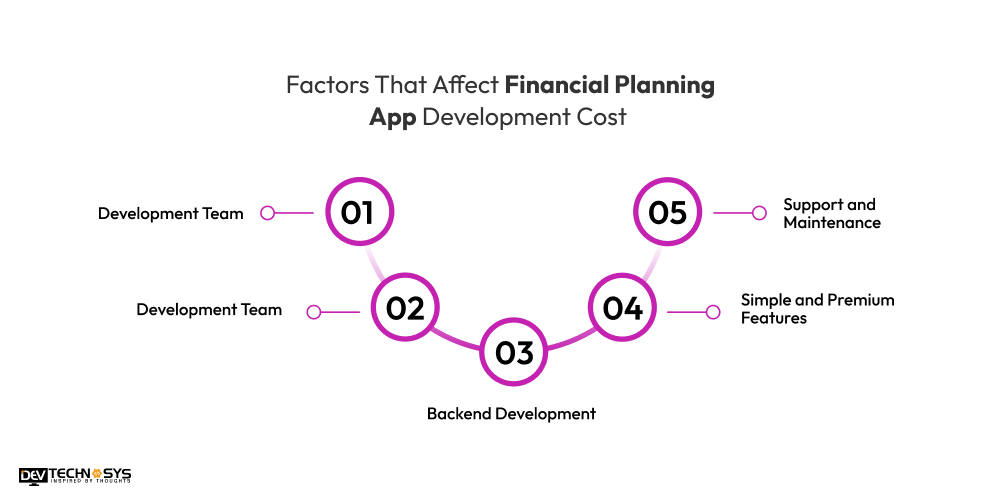
1. Development Team
The development team’s experience and location have a significant impact on pricing. Skilled staff with particular understanding (such as fintech experts) will demand a greater fee.
Outsourcing to lower-cost locations may save money, but it may affect quality and communication. The development team’s higher experience can increase the overall fintech app development cost.
Developer’s Experience Level |
Cost Estimation |
| Entry-Level Developer | $15 – $18/ Per Hour |
| Mid-Level Developer | $18 – $22/ Per Hour |
| Senior-Level Developer | $25+ / Per Hour |
2. Application Design
A well-designed software takes more effort, which might raise expenses. A simple interface is less expensive, whereas elaborate UI/UX, animations, and custom designs increase complexity.
High-quality design increases user engagement, but it comes at a cost in terms of time and resources spent on prototyping, testing, and refinement.
Design Quality |
Cost Estimation |
| Basic Design | $8,000 – $12,000 |
| Complex Design | $15,000 – $22,000 |
3. Backend Development
Backend infrastructure, including databases, APIs, and server-side design, necessitates specialist development that might be costly. A strong backend provides security, data storage, and scalability, but it requires more effort, knowledge, and testing. More complicated features, such as real-time data processing, might drive up backend financial software development expenses.
Backend Development |
Cost Estimation |
| Basic Backend Process | $10,000 – $18,000 |
| Premium Backend Process | $20,000 – $28,000 |
4. Simple and Premium Features
The app’s features have a direct impact on its development costs. Simple features, such as budget tracking and expense categorization, are less expensive to install.
However, premium features like as AI-based financial forecasting, interaction with third-party services, and real-time data synchronization necessitate specialist development, testing, and, in many cases, additional license charges, raising the entire price.
Features |
Cost Estimation |
| Core Features(Budget Tracking and Expense Categorization) | $8,000 – $10,000 |
| Advanced Features(Real-Time Data Syncing and AI-Based Financial Advice) | $13,000 – $19,000 |
5. Support and Maintenance
Ongoing support and maintenance are required to ensure app functionality and address problems or changes. Regular updates, security patches, server monitoring, and troubleshooting increase the cost of maintaining an app.
The frequency and complexity of updates depend on the app’s features, but sustaining performance can necessitate a specialized team and additional funds.
Maintenance Phase |
Cost Estimation |
| Simple Maintenance Phase | $2,000 – $4,000/year |
| Complex Maintenance Phase | $7,000 – $9,000/year |
5 Monetization Techniques of Financial Planning Apps Like Experian
Monetizing financial planning applications like Experian entails employing a variety of techniques to earn income while providing value to customers. Here are five popular monetization techniques:
- Freemium Model
- Subscription-Based Model
- Affiliate Marketing and Partnerships
- In-app Purchases
- Data Monetization
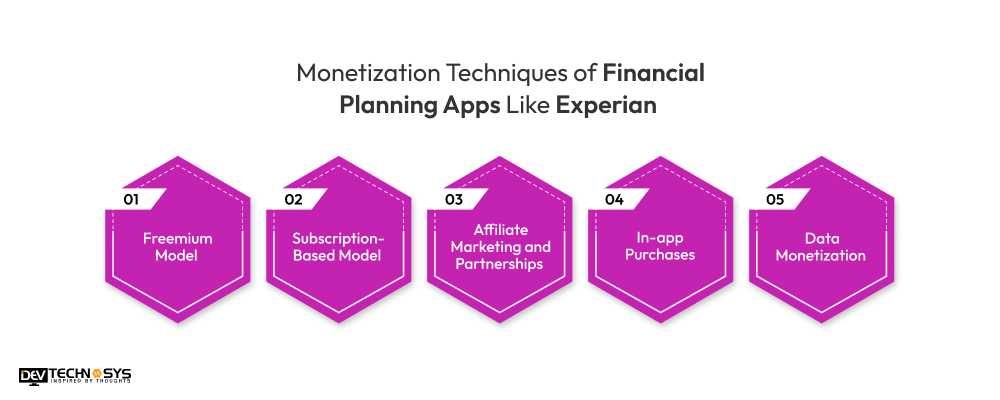
1. Freemium Model
Many financial planning app like PayPal and Experian, adopt a freemium model, with the basic edition available for free and customers charged for premium services.
Free users often have access to crucial features such as budget tracking and cost classification. Premium options, such as credit score monitoring, detailed financial reports, and personalized financial guidance, are available for a membership or a one-time fee.
2. Subscription-Based Model
Another common approach is to use a subscription-based revenue model. Users can pay monthly, quarterly, or annually to have access to additional features and continuing improvements.
This constant funding stream enables continued development and maintenance. Experian app development includes subscriptions plans, such as basic, premium, and enterprise—with varying levels of access to features such as credit reports, personalized counsel, and advanced budgeting tools.
3. Affiliate Marketing and Partnerships
Financial planning applications frequently work with financial institutions, investment businesses, and credit card providers to generate affiliate revenue.
Apps earn commissions when users sign up for or make transactions with third-party products (such as credit cards, loans, or investment accounts). These collaborations provide additional value to consumers while also diversifying the app’s revenue.
4. In-app Purchases
Offering in-app purchases for specific features, tools, or reports enables consumers to pay for only what they require. For example, consumers can purchase a thorough financial report or one-time access to credit score updates.
According to the mobile banking app development company, this method is ideal for consumers who do not want a full subscription but are prepared to pay for specialized content.
5. Data Monetization
Some financial planning applications take anonymous financial data from users (with their permission) and sell it to third-party entities such as banks or marketers.
This information allows brands to better target potential customers. While this can be a profitable revenue source, apps must be clear about their data usage and adhere to privacy requirements such as GDPR.
Conclusion
Developing financial planning application like Experian requires a strategic approach, combining intuitive UI/UX design, robust backend infrastructure, and advanced security features. Key steps include defining core features (budgeting, credit score tracking, financial advice), selecting the right technology stack, and integrating with financial data providers.
Additionally, focusing on user engagement and offering effective monetization strategies, such as freemium models, subscriptions, or partnerships to ensures sustainability and growth.
If you want to create financial planning apps like Experian, share your project requirements with a financial app development company to offer cost-effective solutions.
Frequently Asked Questions
1. How Much Does It Cost To Develop Financial Planning Applications like Experian Like Experian?
Developing a financial planning app like Experian can cost between $8,000 to $25,000+, depending on features, design, platform, security, and development team location. Maintenance and updates add additional ongoing costs.
2. How Much Time Does It Take To Build Financial Planning Apps Like Experian?
To Make apps like Experian typically takes 3 to 6 months, depending on complexity, features, platform, team size, and testing. Ongoing updates and maintenance are needed post-launch.
3. How Do You Ensure Data Security in a Financial Planning App?
Data security in a financial planning app is ensured by using encryption (AES), multi-factor authentication, regular security audits, secure API integrations, compliance with data protection laws, and following best practices for user privacy.
4. Can Users Link Bank Accounts and Financial Institutions?
Yes, many Experian similar apps allow users to link their bank accounts and financial institutions for real-time transaction tracking and credit score monitoring, usually through third-party APIs like Plaid.
